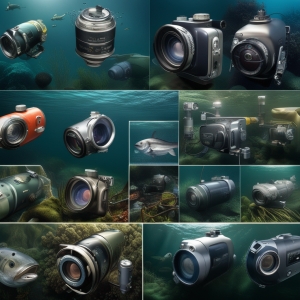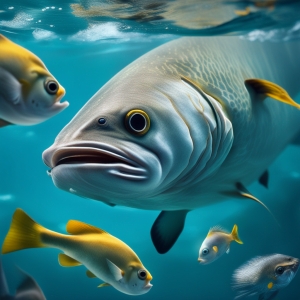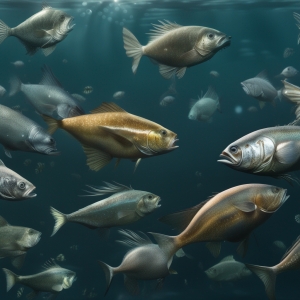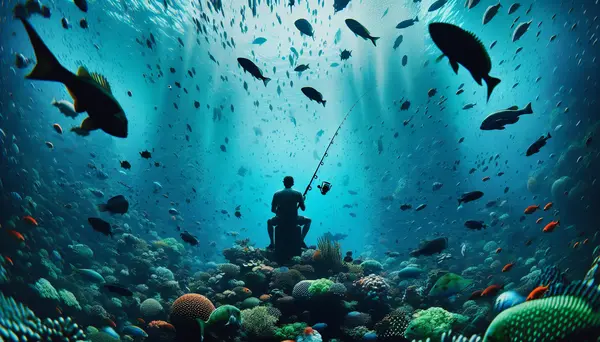Table of Contents:
Introduction to Underwater Cameras for Fishing
Welcome to a whole new world of fishing experience. Whether you're a seasoned angler seeking to upgrade your fishing game or a new enthusiast looking to elevate your fishing experience from the get-go, an underwater camera can be a game-changer.
In today's digital era, the world below the water surface is no longer a mystery. Technology takes us closer to the underwater environment, making fishing more exciting than ever. One of the tools that make this possible is the underwater fishing camera. It is an exceptional piece of technology designed to provide real-time visual insights into the underwater world.
In this article, we will explore how these cameras work, their key benefits, and how you can use them to significantly improve your fishing experience. Perfect for beginners and advanced anglers alike, this guide will help you understand and appreciate this extraordinary tool that is revolutionizing the fishing world.
Why Use an Underwater Camera?
An underwater camera is more than just a tool to capture stunning imagery; it's a radar that locates fish, detects their movement, and helps you understand their behavior. Planning your fishing expedition without one might prove to be a shot in the dark. Here are some compelling reasons to consider investing in an underwater camera for your fishing expeditions.
1. Locating fish: The primary benefit of an underwater camera is its ability to locate fish. With a clear view of what's happening beneath the surface, you can easily spot fish schools or even individual species.
2. Understanding fish behavior: Observing fishes in their natural habitat gives you a unique insight into their behavior. You can learn more about their feeding patterns, what they are attracted to, or what scares them away. It helps you modify your fishing tactics accordingly.
3. Verifying underwater terrain: Getting to know the underwater terrain is another advantage that underwater cameras provide. You can discover and avoid potential hazards such as underwater rocks and vegetation, ensuring your fishing line stays unharmed.
4. Elevating your fishing experience: Lastly, an underwater camera significantly elevates your fishing experience by taking the guesswork out of the equation. With real-time monitoring of the underwater scenery, fishing becomes more engaging and rewarding.
The Impact of Underwater Cameras on Fishing
| Pros | Cons |
|---|---|
| Provides a real-time view of fish behaviours and location | Can be expensive to purchase and maintain |
| Increases the success rate of catching fish | Might disturb natural marine life |
| Allows for targeted fishing, helping to preserve non-target species | Learning to use and interpret the equipment can be challenging |
| Promotes sustainable fishing practices | Dependent on clarity and conditions of the water |
Understanding the Different Types of Underwater Cameras

Ready to go underwater? Not so fast. It's crucial to understand that not all underwater cameras are created equal. They come in different types, each carrying its own set of features suitable for varying fishing conditions. Understanding each one will help you choose a model that best fits your needs and elevates your fishing game.
1. Handheld Cameras: These cameras are compact, portable, and easy to use. Best used for snorkeling or free-diving, handheld cameras allow you to capture high-resolution images and videos of the aquatic life.
2. Mountable Cameras: As the name suggests, mountable cameras are designed to be attached to your fishing gear. They are ideal for capturing the action from a first-person perspective, making it easier to scrutinize and learn fish behavior.
3. Drop Cameras: These are specialized cameras designed to be dropped from a fishing line into the water. Their sturdy build and pressure resistance make them great for deep-sea fishing or ice fishing.
4. Drone Cameras: If you want a bird's eye view of the water body and the surrounding area, there's nothing better than a drone camera. It provides a comprehensive view that can help spot fish schools, feeding areas, or potential challenges.
Each of these cameras is designed for particular scenarios and applications. Depending on your needs and fishing style, you might find one type more suitable than the other.
How to Choose the Best Underwater Camera for Fishing
When choosing an underwater camera for fishing, several factors come into play. It's not only about picking a camera equipped with advanced features, but it's also about identifying the one that suits your needs perfectly. So, how do you make the right choice? Let's explore.
1. Depth Rating: Every underwater camera has a certain depth limit up to which it can perform optimally. The depth rating of your chosen camera should be appropriate for the type of fishing you are into.
2. Image Quality: The quality of images and videos an underwater camera produces is of utmost importance. A camera with a high resolution will offer sharper and more detailed visuals, enhancing your understanding of the underwater world.
3. Battery Life: You certainly wouldn't want your camera to die in the middle of a fantastic fishing excursion. So, always consider the battery life before you buy.
4. Durability: Durability is another important factor to consider in an underwater camera. It should withstand harsh water conditions, pressure, and collisions with underwater objects.
5. Ease of Use: An underwater camera must be user-friendly. Look for a model that offers an intuitive interface, easy controls, and convenient mounting options.
6. Budget: Last but not least, price plays a significant role. Choose a camera that fulfills most of your requirements but is also within your budget range.
Remember, the 'best' underwater camera is not necessarily the most expensive or the one with the most features. It's the one that meets your needs and enhances your fishing experiences.
Using Your Underwater Camera: Tips and Tricks

Acquiring an underwater camera is a significant step forward in enhancing your fishing practice. However, to really take your fishing experience to new heights, it's essential to understand how to effectively use this tool. Below we outline some handy tips and tricks to help you get the most out of your underwater fishing camera.
1. Learn the basic operations: Prioritize becoming familiar with the basic operations, features, and settings of your camera. Read through the user manual and aim to understand things like how to turn it on and off, how to record, and what the various symbols on the camera mean.
2. Check the casing: Ensuring the casing is securely fastened before you launch the camera into the water is critical. This protects the delicate device from potential water damage.
3. Test in shallow water first: Before taking your camera into deep waters, it's highly advisable to do a test run in a shallow pool or similar environment. This allows you to understand how the camera functions and gives you the chance to rectify any issues.
4. Adjust according to visibility: Visibility under water can drastically change depending on various factors like time of the day, weather, water quality, etc. So, learn to adjust your camera settings accordingly to ensure you get the best possible images and footage.
5. Regular maintenance: After every fishing trip, you should clean and maintain your underwater camera. This includes washing off any sand and saltwater, drying, and properly storing the device to ensure a longer lifespan.
6. Footage review: Regularly review your footage. Not only does it help improve your angling techniques, but it's also an opportunity to ensure your camera is functioning as expected. Any anomalies in the footage might indicate a need for camera servicing or adjustment.
Wrapping Up
To sum it up, underwater cameras are an incredibly useful tool for modern fishing. They deliver real-time insights into the underwater world, helping anglers locate fish, understand their behavior, and navigate potential underwater hazards. More than just a gadget, they revolutionize the way we fish, making the experience more engaging, exciting, and rewarding. Lastly, like any piece of equipment, knowing how to use and maintain an underwater camera effectively will ensure its long-term functionality and improve your exploits in the sunny world of fishing.
The Impact of Underwater Cameras on Fishing

Unlike traditional fishing where knowledge and luck played major roles, fishing with an underwater camera tremendously increases the chances of a good catch. They have transformed the fishing experience by turning it into a visual treat—providing a realistic representation of the aquatic environment.
The integration of underwater cameras in fishing has several notable impacts:
1. Skill Enhancement: By allowing a peek into the underwater world, these cameras enable anglers to accurately observe fish behavior and their responses to different lures. This helps in refining skills and adopting better strategies that directly improve their catch rate.
2. Increased Catch Success: Underwater cameras practically eliminate the guesswork in fishing. Anglers can directly view where the fish are and what they are doing. This invariably leads to increased catch success as the opportunity to strike is based on real-time information rather than guesswork.
3. Environmental Awareness: Underwater cameras help anglers become aware of the underwater environment in which they fish. This knowledge can help protect the environment by avoiding areas with sensitive ecosystems.
4. Ethical Fishing: Additionally, the use of underwater cameras encourages ethical fishing practices. Anglers can identify and target specific species, which reduces the chances of catching non-target species or undersized fish.
No doubt, the advent of underwater cameras has profoundly changed the landscape of fishing. It has shifted the paradigm from traditional experience-based fishing to a more knowledge and technology-driven activity.
Despite these advancements, it's vital to remember to use technology responsibly and maintain an ethical approach to fishing. After all, balancing our enjoyment of fishing and preserving the aquatic ecosystems is the key to sustainable fishing.
Conclusion: Enhance Your Fishing Experience with Underwater Cameras
From transforming the way we discover and interact with the underwater world, to making fishing an even more rewarding experience, underwater cameras are revolutionizing the angler's journey. Equipped with an understanding of the benefits and types of these cameras, you're now ready to dive beneath the surface and explore new perspectives in your fishing adventures.
Experience the thrill of observing fish behavior firsthand, navigate the underwater terrain with confidence and fine-tune your strategies based on real-time feedback. Owning an underwater camera is not just about technology, it's about the joy of unlocking and embracing new possibilities. And perhaps most importantly, witnessing the fascinating life under the water surface, and becoming more connected with the unique world below.
Investing in an underwater camera marks a significant stepping stone for any angler seeking to elevate their fishing journey. And with a plethora of options available, you're sure to find the perfect fit to satisfy your fishing aspirations and needs. So brace yourself, because fishing is never going to be the same again with your new underwater companion!
FAQ: Enhancing Your Fishing Experience with Underwater Cameras
What are underwater cameras?
Underwater cameras are specially designed cameras that can be submerged in water to capture images and videos of the underwater world. They are often used in fishing to get a clear view of the fish and their behavior.
How do underwater cameras enhance fishing experiences?
Underwater cameras provide anglers with a unique perspective of the marine life, giving them the opportunity to study the behavior of the fish, understand their habits, and identify their habitats. This helps in improving the chances of a successful catch.
How to choose the right underwater camera for fishing?
The right underwater camera for fishing depends on several factors - the depth you will be fishing at, the clarity of the water, the type of fish you are targeting, and the lighting conditions. You should also consider the camera's durability, battery life, and ease of use.
Are underwater cameras difficult to use?
Most underwater cameras are designed for easy setup and usage. Usually, they come with a cable that can be attached to your boat above water level. The camera then sends real-time images or video to a screen on your boat, allowing you to view the underwater world.
Can you use underwater cameras in any type of water bodies?
Yes, underwater cameras can be used in both freshwater and saltwater environments. However, it's crucial to ensure the camera is appropriately rated for the level of water resistance required for your specific fishing environment.







